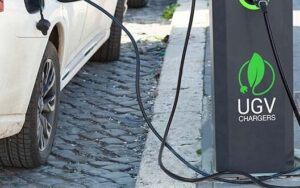
In February, registrations of electric vehicles (new and used) in Ukraine increased 2.3 times compared to the same month in 2023 – up to 3.924 thousand units, including the share of new ones at 24%, Ukravtoprom reported on its Telegram channel.
The bulk of the electric vehicles registered during the month were passenger cars – 3,881 thousand units (new – 926 units, used – 2,955 units), and only two of the 43 commercial vehicles were new.
The top five new electric cars on the market in February were formed by: Volkswagen iD.4 – 257 units; BYD Song Plus – 104 units; Honda eNS1 – 96 units; Nissan Ariya – 71 units and Honda M-NV -49 units.
The TOP-5 of the first-time registered used cars in January included Nissan Leaf – 416 units; Tesla Model 3 – 380 units; Tesla Model Y – 279 units; Volkswagen e-Golf – 210 units and Hyundai Kona Electric -161 units.
As reported, in January of this year, Ukrainians purchased more than 3.5 thousand electric vehicles, which is 2.8 times more than in January 2023, with the share of new cars amounting to 24%.
In total, 7.5 thousand electric vehicles were registered for the first time in Ukraine in two months, 2.5 times more than a year earlier.
In 2022, according to Ukravtoprom, registrations of electric cars in Ukraine increased 2.8 times to 37.6 thousand, with new cars accounting for 20% compared to 17% a year earlier.

Export sales of Ukrainian wheat are steadily growing. Since the beginning of February, more than 2 million tons have been contracted, which could be a record volume of deliveries for the season. As of March, 1.4 million tons of wheat have already been sold.
This issue was discussed on February 20 during the weekly briefing organized by the analytical center of the First Agricultural Ukrainian Cooperative (FUAC), created within the Ukrainian Agri Council.
“Traders say that Indonesia is very actively involved in purchases of Ukrainian feed wheat. This Asian country has sky-high prices on the domestic market and is interested in importing grain. The demand price from Indonesia is USD260-265/t CIF. It is very profitable to export Ukrainian wheat to Indonesia. The fly in the ointment for these plans is the conflict in the Red Sea, where there is a high risk of shelling of the merchant fleet. This is still a systemic problem that negatively affects trade in the Black and Mediterranean Seas. The risk is holding back Ukrainian traders from fixing their positions in this direction. The market expects that in the second half of March, the passage of ships through the Red Sea may stop completely. A logistical solution would be to detour ships by sea through Africa, but this will raise the cost of freight by USD10-12 per ton,” was mentioned by the FUAC.
Ukrainian wheat continues to be the cheapest on most markets.
“Last week, Ukraine sold wheat with a protein content of 12.5% to Egypt at USD224 per ton for delivery to Egypt. For comparison, Russian wheat cost USD245 on an FOB basis. Ukrainian wheat is very cheap compared to other grains in the EU, Egypt and Turkey. The trade tries to keep prices low so that it makes sense to trade on many bases. Price gaps are large, which keeps the CPT market at low levels. Nevertheless, there are more and more sellers of wheat on FOB basis, many farmers are willing to sell for USD195 per ton at the Danube ports. At the same time, on CPT terms, wheat costs USD175-188 per ton, and by the end of the week, the price tags may lose another USD2 per ton,” added the analytical department of the FUAC.

The demand for diagnostics and endoscopic examinations has not declined critically since the start of the full-scale war, but the financial factor had a significant impact on the decline in demand, experts interviewed by Interfax-Ukraine believe.
“At the beginning of the full-scale invasion, for objective reasons, the demand for medical services, among which diagnostics plays a significant role, decreased. However, unlike in other areas, the direction of medical services to relatively safe regions of the country did not have critical consequences. Obviously, this is due to the large number of temporarily displaced persons, including many children and young people who are working,” said Yaroslav Mudry, an endoscopist at the Leleka Multidisciplinary Medical Center.
At the same time, according to him, “against the background of general inflation, the cost of endoscopic diagnostics has also increased.”
He emphasized that, just like before the full-scale war, Ukrainians’ visits to medical institutions for diagnostics are most often caused by symptoms of existing diseases or control observations after treatment, in particular, control after tumor removal or diagnosis of tumors at late stages.
“Unfortunately, the level of preventive diagnostics and research is extremely low,” said Mudryi.
In particular, he emphasized that in Ukraine, compared to other European countries, the number of patients with colorectal cancer, which often has no symptoms, remains quite high, but “there is currently a positive trend, we see an increase in the number of cases of early diagnosis (screening colonoscopy).”
“I am convinced that this situation looks optimistic,” said the endoscopist.
At the same time, Mudryi emphasized that Leleka uses “all possible factors to increase the level of effective diagnosis of masses (colon polyps), which, in turn, will reduce the level of new cases of colorectal cancer.”
The clinic’s specialists help patients at the most difficult stage – preparation for the procedure, which helps to improve the quality of diagnosis, and during the examination they use additional accessories and disposable consumables to remove the tumors.
For her part, Lyudmyla Svatko, Head of Diagnostic Service at Adonis Medical Group, also noted that since the beginning of the full-scale invasion, “we have experienced a decrease in the flow of patients, but this was more related to the evacuation, but with the return of the population, the need for diagnostics has increased, even increased due to the exacerbation of health problems due to stress and adverse conditions.”
“We have returned to the pre-war level of utilization of our diagnostic departments, and we even see an increasing demand,” she said.
According to her, MRI of the head, cervical and lumbar spine, and knee examinations are currently in the highest demand among the population.
In addition, thanks to Adonis’ active cooperation with charitable foundations, the clinic conducts a significant number of studies related to military injuries, including the effects of shell shock, trauma, shrapnel detection, and studies related to preparation for further rehabilitation at the clinic.
In addition, Adonis notes an increase in demand for mammography and breast MRI among women, which doctors attribute to the constant stress Ukrainian women are under.
At the same time, Svatko noted that studies using large medical equipment, such as CT and MRI, are key to diagnosing the wounded and continue to be in demand among the study population.
“Unfortunately, we state the fact that patients have started to undergo annual examinations untimely due to the displacement and are coming with more serious diseases that require more complex studies,” she said.
At the same time, Svatko noted that Adonis is one of the few medical networks that have not stopped working since the beginning of the war and can always provide qualified medical care.
“Our diagnostic equipment has fully autonomous power sources in case of water and electricity outages, so we can see patients without reducing turnover regardless of the circumstances,” she said.
At the same time, Svatko estimates that the cost of servicing imported large medical equipment has increased since the start of the full-scale invasion.
“Now the service takes up most of the budget, we wait longer for repairs because it is related to logistics and the situation with carriers on the border with Europe. It has become more difficult to service and maintain the equipment,” she said.
DEMAND, diagnostic services, diagnostics, medical clinics, Mudry, Stork, АДОНИС, Сватко

Initial registrations of used passenger cars imported to Ukraine from abroad in October 2023 increased by 41% compared to October 2022 – to 21.3 thousand units, which is 1% more than in September this year, the Ukravtoprom association reported on its Telegram channel on Monday.
According to the association, the largest share in the segment of imported used cars in October consistently belonged to gasoline cars – 44% (in September, too), followed by diesel cars – 31% (unchanged), electric cars – 17% (16%), cars with LPG – 5% (unchanged) and hybrids – 3% (4%).
Volkswagen Golf remains the leader in registrations (1544 units), and the top five remained unchanged: Renault Megane (1200 units), Skoda Octavia (960 units), Volkswagen Passat (785 units) and Nissan Leaf (573 units).
The TOP-10 of this market in October also included Volkswagen Tiguan (451 units), Tesla Model 3 (442 units), AUDI A4 (416 units), Ford Focus (411 units) and Nissan Qashqai (404 units).
The average age of used cars that switched to Ukrainian license plates in October is 9.5 years.
Overall, in January-October this year, 169.3 thousand used cars imported from abroad were registered for the first time in Ukraine, which is 3.4 times more than the number of new cars sold in the same period.
As reported, in 2022, Ukrainians registered 388.5 thousand imported used passenger cars, which is almost a quarter less than a year earlier, but more than 10 times more than the market for new passenger cars.

Registrations of new passenger cars in Ukraine in October this year increased by 83% compared to October 2022 – up to 5.7 thousand units, and are 0.7% higher than in September 2023, Ukravtoprom reported on its Telegram channel.
According to the association, Toyota continues to hold the lead in the market with a 40% increase in registrations by October last year – up to 929 units, Volkswagen’s second result is 574 cars (three times more), and Skoda (in September – 4th position) took third place, pushing BMW aside, with an increase of 46%, up to 477 units.
BMW’s fourth result is 461 cars (up 3.6 times), and Renault closes the top 5, as it did a month earlier, with 432 cars (+60%).
The top 10 in October 2023 also included: Nissan – 309 units; Hyundai – 240 units; Mercedes-Benz – 224 units; Mazda – 220 units; Peugeot – 200 units.
The title of the month’s bestseller, as in September, went to the Renault Duster with 387 registrations (in October 2022, it was the Toyota RAV4 crossover).
“Ukravtoprom states that in January-October 2023, Ukrainians purchased and registered 49.6 thousand new passenger cars, which is 60% more than in the same period last year.

By the end of this year, metal prices and logistics costs have dropped significantly, which should help the demand
Russia’s military aggression against Ukraine has had a significant impact on the entire economy and the construction industry in particular. However, after a few months of war, some of the customers have already returned to the construction of commercial objects that were frozen at the beginning of the full-scale war or damaged as a result of the hostilities.
Current situation
Rauta is a leading supplier of modern solutions for quickly erected buildings – sandwich panels, ventilated metal facades, steel frames, load-bearing profiles, etc. The company offers services in design, installation of supporting and enclosing structures, as well as general contracting on objects of any complexity. The main focus of the company’s business is the import of Ruukki products for commercial construction projects. We use production facilities located in Poland, Estonia and Ukraine.
After the beginning of the active war phase due to a significant decrease in demand for our products the company’s business was significantly reoriented. We began to be approached by clients with requests to rebuild buildings destroyed in the fighting. Having a deep understanding of the technologies and principles of reconstruction, we began to actively engage in the restoration of buildings and made it a separate line of business. Whereas before February 24 the company was restoring only one building in Kiev, by the end of 2022 we had implemented 7 projects in three cities of Ukraine, and the start of reconstruction of several more is planned for 2023.
Growth against the backdrop of a falling market
In 2021 there was a situation on the market when the demand for Ruukki products greatly exceeded the capacity of production and the factories were not able to fulfill all orders. Starting from 24 February, the number of orders for new construction projects decreased sharply, and the main deliveries were for objects that began construction last year. Fortunately, almost all of our sandwich panel customers continued to build facilities. Among them are low-temperature warehouse and business center in Kiev, dairy farm and dairy plant in Ternopil region. Therefore, in 2022 Rauta has a 40% year-on-year decrease in sales, which is a relatively good indicator against the background of a more than 70% fall in the sandwich panel market. At the same time, thanks to the growth of the construction and general contracting services area, the company’s total revenue increased by 7% compared to 2021.
Price waves
Ruukki products are made only from European rolled steel, the price of which rose to a peak in August 2021 and halved in early 2022. At the same time in the cost of panels, galvanized steel with polymer coating accounts for about 25%.
At the same time, given the substantial increase in the cost of transportation services and the rise in the euro, the price of imported sandwich panels for the year increased by 50% in hryvnia equivalent. Nevertheless now there is a tendency in the market to considerable decrease of transport cost as well as inertial fall of world steel prices that in the nearest perspective can lead to reduction of sandwich-panels prices by 15-20%.
The main method of delivery in the market of metal construction is road transport. In 2021 the cost of delivery by truck from Poland to Kiev was about 65 thousand UAH. In the spring of 2022 delivery from Poland due to rising fuel prices and limited supply of transport has doubled in price, and in December 2022 was back to the prewar level.
In 2021 the peak cost of load-bearing steel reached almost 70 thousand UAH per ton, mainly due to the high cost of rolled steel. At the end of 2022 due to the decline in metal prices by almost half the cost of steel decreased by about 23% – to 54 thousand UAH per ton.
Recovery Opportunities.
In the spring of 2022, when the company had less workload on the main projects, we have developed a technology for the construction of frameless houses made of sandwich panels, which can be used for ultra-fast construction of houses and cottage towns. To demonstrate the benefits of this technology, we plan to install two demonstration frameless houses near Kiev. For this purpose we have already made house sets in Poland for 20 and 40 square meters houses and we are going to install them in spring. Now we can see the interest in this technology on the part of institutional funds and private investors in the segment of cottage building, which will grow rapidly after Ukraine’s victory.
Another innovation of ours is the development of technology for construction of multistoried buildings using sandwich panels as outer walls, which allows a developer to get up to 5% more space.
In general it can be noted that the technology of rapid construction with steel solutions has a great perspective in the reconstruction of commercial real estate – where the investor understands: the sooner the business is built, the sooner it will begin to bring income.
CONSTRUCTION, DEMAND, galvanized steel, RAUTA, STEEL, STEEL CONSTRUCTION